The latest models of the iRobot line up are the s9 series. Currently, there are only two models to the series, the Roomba s9 and the Roomba s9+. Why did iRobot create one of the greatest robot vacuums ever only to make two of them?
In short, the plus means it comes with the auto-emptying docking station. In this article, I will explain the differences and similarities between the two robots.
I will examine the features, options, and exclusive details of the two machines. By the end, you will have a better idea of which model is better for your needs, and we will answer why there are two s9 models.
Contents
- 1 Differences between the Roomba s9 and s9+
- 2 Similarities between the two Roombas
- 3 Specifications Chart
- 4 Comparing The Roomba s9 and Roomba s9+
- 5 Real-World Performance of the Roomba s9 Robots
- 6 Frequently Asked Questions
- 6.1 Q. What type of warranty to the s9 robots have, and how do I make a claim?
- 6.2 Q. Is the Roomba s9 or s9+ good for small homes?
- 6.3 Q. I see cats riding Roomba vacuums in videos all the time, is this okay?
- 6.4 Q. I have multiple staircases, and one is a spiral staircase. Will the s9 be able to clean the stairs without falling off?
- 6.5 Q. Can I reuse the collection bags in the Clean Base?
- 7 What I Like About the Roomba s9
- 8 What I Like About the Roomba s9+
- 9 Conclusion
Differences between the Roomba s9 and s9+
[easyazon_image align=”none” height=”500″ identifier=”B07QWN31YH” locale=”US” src=”https://smartrobotichome.com/wp-content/uploads/2019/11/41kpcsFqDOL.jpg” tag=”srh-easyazon-20″ width=”500″]
[easyazon_image align=”none” height=”500″ identifier=”B07QXM2V6X” locale=”US” src=”https://smartrobotichome.com/wp-content/uploads/2019/11/41xk3TcS39L.jpg” tag=”srh-easyazon-20″ width=”500″]
Contrary to some misconceptions, there are only three differences between the Roomba s9 and s9+. Let’s see what they are.
- Clean Base Disposal System. The “Plus” for the s9+ is the addition of the Clean Base. The charging station has a motor, high-efficiency filter and dust bag. The robot will have its collection bin emptied automatically when docking. The s9 model uses the Home Base charging station that doesn’t empty the collection bin.
- Automatic Disposal System collection bin. The collection bin for the s9+ has an access hole where the dirt and debris are removed by the Clean Base. The s9 model doesn’t have an access hole in its collection bin.
- The s9+ costs more than the s9 model because of the Clean Base Disposal System.
Similarities between the two Roombas
Aside from the three differences listed above, every other aspect of the robots is identical. Let’s take a look at the significant elements of the robots.
- Recharge and Resume capabilities. Both robots will monitor their battery levels, and when they get low, the vacuums will return to the charging stations. Once the batteries are charged, they will resume cleaning from where they left off.
- Imprint Technology. With Imprint Link, the s9 robots will communicate with the Braava M6. Imprint Smart Mapping allows the vacuums to create and store up to 10-floor plans. The maps have user interaction and controls, as well.
- Square front design. The s9 is the first Roomba not to be a circle-shape. Instead, the front end is squared off to allow better edge and corner cleaning.
- Mobile app and voice controls. Both s9 models use every feature on the mobile app that has recently been redesigned just for their release. As a result, they also use more voice commands than any other Roomba model through Amazon Alexa and Google Assistant.
- Tangle-free rubber extractors. The patented dual-extractors are now 30 percent larger and moved more to the front of the s9 robots for more suction power and better collection.
- Side brush redesign. The side brushes are now softer, more substantial, and rotate slower. The exhaust air has also been diffused and redirected to prevent the side brushes from blowing debris around the room.
Specifications Chart
Here we will cover the two robots in a side by side comparison so you can see all of the features and options in one place. Enjoy.
| Roomba s9 | Roomba s9+ | |
| Size | 12.25 x 12.25 x 3.5 inches | 12.25 x 12.25 x 3.5 inches |
| Weight | 8.15 pounds | 8.15 pounds |
| Navigation | iAdapt 3.0 | iAdapt 3.0 |
| Battery | Lithium-Ion | Lithium-Ion |
| Runtime | Up to 120 minutes | Up to 120 minutes |
| Charge Time | 3 hours | 3 hours |
| Automatic Recharge | Yes | Yes |
| Entire Level Clean | Yes | Yes |
| Filter | High-efficiency | High-efficiency |
| Carpet Boost | Yes | Yes |
| Drop Sensors | Yes | Yes |
| Bump Sensors | Yes | Yes |
| Dirt Detection Sensors | Yes | Yes |
| Camera Navigation | Yes | Yes |
| Wireless Communications | Yes | Yes |
| Mobile App | Yes | Yes |
| Voice Controls | Yes | Yes |
| Floor Types | All | All |
| Imprint Smart Mapping | Yes | Yes |
| Imprint Link | Yes | Yes |
| Collection Bin Capacity | 0.55L | 0.55L |
| Washable Collection Bin | Yes | Yes |
| Home Base Charging Station | Yes | No |
| Clean Base Charging Station | No | Yes |
| Automatic Collection Bin Emptying | No | Yes |
| Side Brushes | 1 Side Brush | 1 Side Brush |
| Containment | Separate Purchase | Separate Purchase |
| Warranty | 1 Year | 1 Year |
| Price | Check on Amazon | Check on Amazon |
Comparing The Roomba s9 and Roomba s9+
Now I will walk you through all of the essential and significant aspects and elements of the Roomba s9 model robots. You will get a better idea of how these robots operate and what they are truly capable of.
Automatic Disposal System
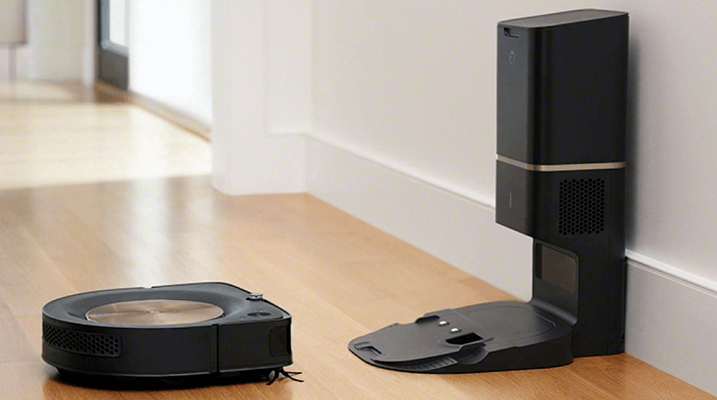
One of the biggest robotic vacuum advancements in the last few years is the automatic disposal system. First appearing in the Roomba i7+, the robot will have its collection bin emptied every time it docks.
The Clean Base is the name of the charging station that does the bin emptying. It has a high-speed motor that creates suction when the robot docks. The suction lifts the rubber blocking the access hole in the collection bin and pulls the debris out. The dirt and debris travel into the Clean Base and are deposited into a large bag.
The bag is similar to those old vacuum bags that we used to struggle with putting in the zippered compartment of our grandma’s red Hoover. There isn’t a struggle with these bags, though. To remove, you open the top of the Clean Base and pull up on the bag handle. There is a rubber trap-stopper that will close as soon as the bag is lifted, locking the dust and debris inside.
You then toss the entire bag in the garbage without making a mess. The good news is that you can go about a month without having to replace the collection bag. The bad news is that you get two bags with your s9+ purchase and then have to buy more.
Roomba s9 is More Conventional
The s9 model doesn’t have the Clean Base or automatic disposal system. Instead, you get the standard Home Base charging dock, and the collection bin doesn’t have an access hole to have the debris sucked out.
Since this is the primary difference between the s9 and s9+ models (as well as the difference in the i7 and i7+ models, too), I will cover the features in detail from this point forward, speaking on both the s9 and s9+. Instead of a comparison, you will get information on the features and options. Ready? Let’s get into it.
Basic Operational Features
Every robot vacuum is comprised of the same basic internal aspects. The battery, for example, powers the entire robot and helps the computer store the maps and programming in the memory.
The s9 robots use a 3600mAh lithium-ion battery that will run for about 120 minutes per charge. The robot also monitors its battery. When the battery level drops below 10 percent, the robot will stop the cleaning cycle to recharge the battery. After the battery is full, the Roomba s9 will return to the exact spot it left off from and resume cleaning. The Recharge and Resume feature have been a Roomba staple since the 900 series robots.
Extractors and Side Brushes
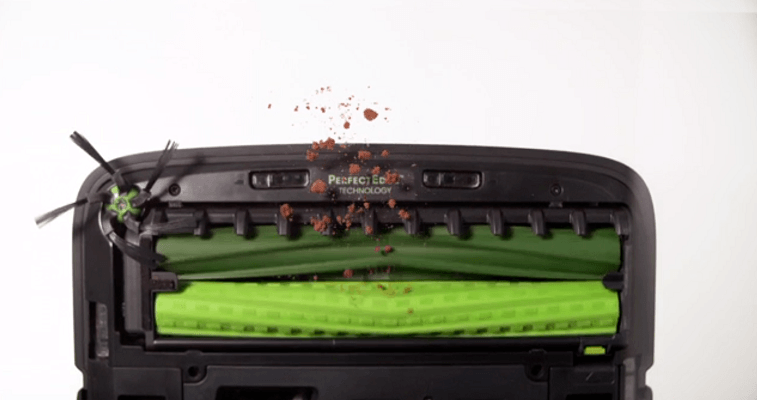
The s9 saw significant improvements in the brushes and extractors. For starters, the dual-rubber extractors were enlarged by about 30 percent. They were also moved from between the driving wheels to the front of the robot. This repositioning allows for more suction power at the spot of the extractors, resulting in a deeper clean of your floors.
One of the biggest complaints of past Roomba models was that they seemed to spread lighter debris around while cleaning. Even though eventually, all of the debris and dirt on the floors were picked up, in some instances, the robots appeared to make a larger mess than they cleaned up.
This has been addressed in the Roomba s9 and Roomba s9+. The side brush is now slightly larger and made of a softer bristle material. The biggest change, though, is that they now spin much slower. The slow speed prevents lighter debris from being flung around the room.
To help combat light debris from being blown around, the exhaust air is now diffused. Instead of a powerful air stream pointed directly at the floor, which can easily blow light debris around, the air is passed through a diffused vent to slow the force of the air, and it is pointed more upward. The result is debris that stays where it lays until the side brush or extractors collect it.
Driving Wheels
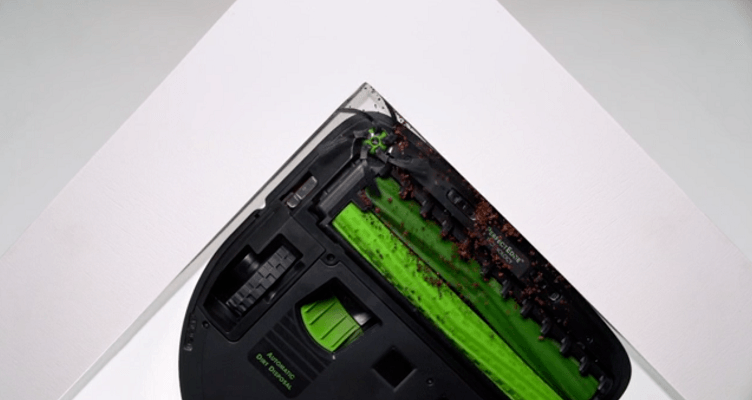
Another change that you may not notice right away is that the driving wheels are more capable now. They are slightly larger and can climb over larger obstacles. Transitioning from hard flooring to carpeting is less of an issue. Previous models had to find the right angle of approach. The s9 models now just easily go from one to the other.
You will also notice that larger thresholds are no match for the wheels any longer. If your past robots had issues getting from one room to the other because of taller or wider thresholds, this is no longer an issue.
Filtration Doesn’t Change Much
There hasn’t been a significant change to the high-efficiency filter used in the Roomba s9 models since the 900 series. There also hasn’t been a reason to do so. The high-efficiency HEPA filter captures particles down to 3 microns. This helps eliminate up to 99 percent of in-home allergens such as pet dander, dust mites, and pollen.
The one change was made in the Clean Base charging station. The Clean Base for the Roomba i7+ has a standard filter installed. However, the s9+ Clean Base changed to a quieter motor, as well as a high-efficiency filter. Now all of the allergen-sized particles that made it into the collection bin are filtered during the collection bin emptying process.
Bottom Line: There have been significant changes (as well as some not so significant) with the release of the s9+. These basic functions only work to improve the overall quality of the clean and operation of the robots.
Control Options Receive an Upgrade
For the longest time, Roomba robots had exclusive local controls. If you wanted to set the time, create a schedule, or start a cleaning session, you have to push buttons on the robot itself. Eventually, iRobot released its Home app.
The app quickly became one of the most prominent features of Roomba robots. It continues to top the industry expectations. With its easy to use interface, simple controls, and simple setup, the iRobot Home app is a favorite among robot vacuum owners.
Recently, the app underwent a drastic change. With the release of the Roomba i7 and i7+, the app saw new features added. While you can still control the robot, set, edit and cancel schedules, and see status updates, the s9 series takes it a step further.
With Imprint Technologies (discussed below), new features and options are opened in the app and, as a by-product, into the voice commands.
Now you can not only see the map of your floor plan; you can interact with it. You can also use new voice commands through Google Assistant and Amazon Alexa devices that aren’t available for any other Roomba robot (except for the i7 series, of course).
While there are still local control options, they are limited. You can start and stop a cleaning session, perform a spot clean, and send the robot back to the charging station. If you want any other control options, you will need to use the mobile app or voice commands.
Bottom Line: The improvements are notable, useful, and commendable. A lot of time and effort has been put into the mobile app controls, and it shows. This version of the iRobot Home app is the best yet.
Imprint Technology Continues to Improve
Once again, a feature introduced with the Roomba i7 is improved upon with the Roomba s9 series. Imprint Technology is a two-part system that enhances the functionality of the robots.
Imprint Link
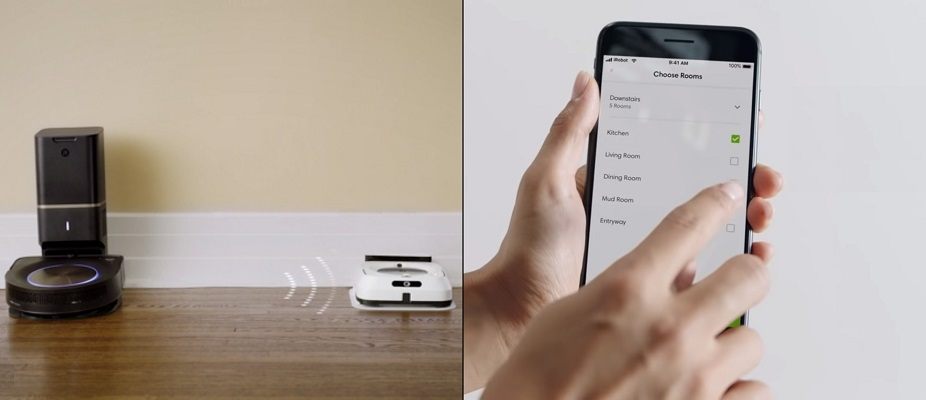
First is Imprint Link. This is an exclusive feature of iRobot. It allows communication between the s9 models and the Braava M6 mopping robot. How it works is that you link the two robots through the mobile app. Once this is done, when you start a cleaning cycle (or a scheduled cleaning session begins), the Roomba s9 will start first.
As the Roomba finishes a room with hard flooring, it will alert the Braava that the sweeping is completed. The Braava, then, will begin mopping the floor behind the Roomba. You can also set it up, so they work at the same time. You can have the Roomba vacuuming the living room carpeting while the Braava M6 mops the kitchen.
Imprint Smart Mapping
The second aspect is known as Imprint Smart Mapping. The Roomba s9+ will take a mapping run (or two, or three) to build a complete, three-dimensional map of your home. This map will be displayed on the mobile app.
Through the mobile app, you now have the ability to interact with the map. You can name the individual rooms, for example. Then, you can select specific rooms of your home that the Roomba will clean.
For instance, if you only want the living room and bedrooms cleaned, you can select these rooms on the mobile app and then start a cleaning cycle. The Roomba will begin cleaning and only travel to those rooms.
Another feature of the Imprint Smart Mapping is the ability for the Roomba s9 to map and store up to ten different layouts. If you have multiple floors, for example, each floor will be mapped separately.
When you move the robot to a different floor, it will recognize where it is and use the associated map to do the cleaning. What is interesting is that a secondary mapping run is no longer needed. If you rearrange all of the furniture in your living room, the Roomba will still know which map it should use. When it cleans the living room, it will update the map for that room only, as it cleans. No other robot can make this claim.
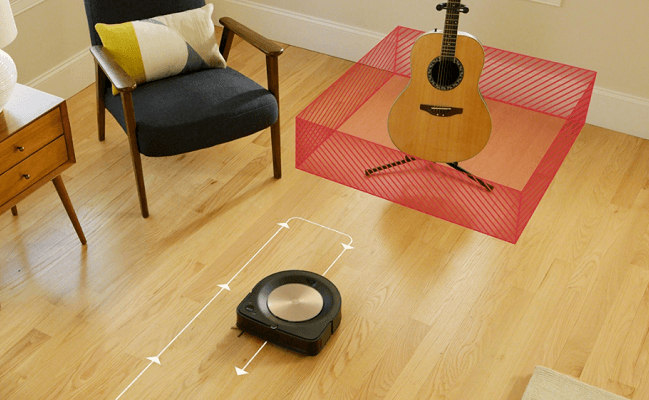
Finally, a new feature (as of October 2019) is called Keep Out Zones. Instead of preventing the robot from cleaning an entire room, you can draw squares on the mobile app map. You can position these squares, change their size or rotation. When you are satisfied, save the map. These square areas will be ignored by the Roomba s9 and s9+ as if they were physical walls or barriers.
This feature, along with the rest of the Imprint Smart Mapping, renders the need for virtual wall barriers mute. While the Roomba s9 and s9+ are still compatible with the dual-mode virtual wall barriers, you really don’t need them anymore. That saves you money from making another accessory purchase.
Bottom Line: Imprint Technology is a massive advancement in robotics. If you also own the Braava M6 mopping robot, you will get the most use out of the feature. The mapping intelligence has once again raised the bar of what is expected.
Can You Upgrade the Roomba s9?
Because there is no difference in the two robots aside form the Clean Base and special collection bin, it is possible to upgrade the Roomba s9 to the Roomba s9+. iRobot sells the Clean Base system separately.
When you make the purchase, you only need to install and power on the Clean Base and inset the new collection bin into the s9 robot. Once you connect the Clean Base to the wireless network and it pairs with the robot, you now have the Roomba s9+.
If you know you want the s9+ right out of the gate, it is less expensive to purchase the s9+ rather than upgrading later. However, if you are in the mode of saving some money, you can purchase the Roomba s9 and then, later on, purchase the Clean Base system for the upgrade. It will cost you about $50 more to do the upgrade later, though. Think about your decision before you make a final purchase.
Bottom Line: Upgrading the s9 is possible. It will cost you about $50 more to do the upgrade than it will to purchase the s9+ outright, though.
Real-World Performance of the Roomba s9 Robots
It is important to know how your new robot will perform when you get it home. Here, I will show you what the claims being made are and how they can make such claims. Then we will explore what you can genuinely expect after unboxing your Roomba s9+.
Lab Testing is Biased
When a robot vacuum company makes a claim, it is done after extensive testing. Their testing lab is set up to mimic a home, with carpeting, obstacles, and hard flooring. The testing team then places various types of debris on the floor and watches as the robot cleans the mess.
What isn’t so well known is that these lab tests don’t mimic real-world applications. I highly doubt you run around your home lightly sprinkling pre-measured amounts of loose hair and dry cereal. Your home also has high-traffic areas, things like rugs that get moved around, etc.
When you do spill a bowl of cereal on the floor, there is probably milk involved, also. The baby in the high chair is going to toss peas and dry cereal on the floor. Before you notice it and have the Roomba clean it up, though, you are going to step on it (accidentally, of course), grind it into the floor, or make even smaller pieces.
Claims made by the robot manufacturers aren’t lies, but they are strictly controlled, retested, and biased until they have a number high enough to brag about.
Roomba s9 Cleaning Carpeting
On carpet, there really is no better robot than the Roomba s9. Not only do the rubber extractors agitate deep into carpet fibers, but the improved suction power and carpet boost features get the smallest of debris from your carpets.
The vSLAM navigation and mapping allow the robot to clean each square foot with precision. The robot will first move along the edges of the room and then a quick run using parallel lines to cover the entire floor.
A second pass will be done to get a thorough and deep clean in all areas of the room. Once done, the s9 will continue on to the next room. What is also impressive is that the Roomba s9 does all of this much faster than any Roomba before. Averaging less than 18 minutes per room, the clean is deep, thorough, and speedy.
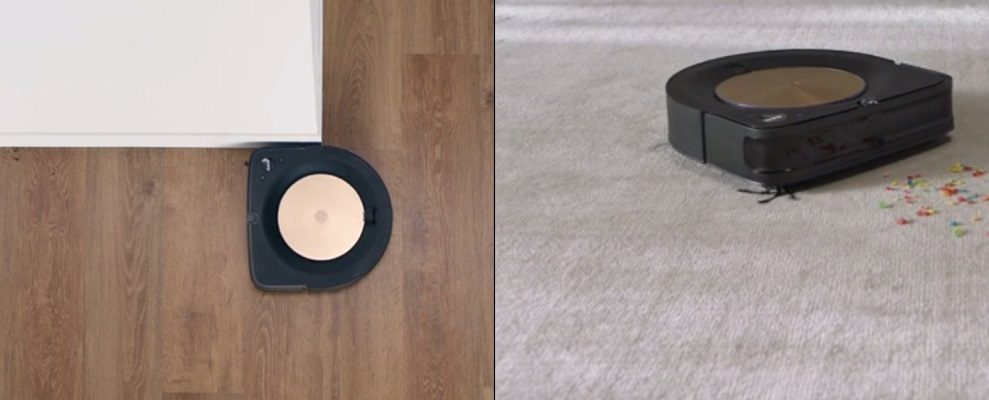
Roomba s9 Cleaning Hard Flooring
On hard floors, the Roomba s9 and s9+ do an incredible job. The large rubber extractors don’t miss anything and won’t scratch any surface, no matter how soft. The square front design allows the robot to get all the way into corners and along the edges better than ever, too.
While not particularly a design feature, the Roomba s9 will also be able to scrape up most of the dried-on messes, such as a liquid ring that has been forgotten when pouring a drink. Don’t be fooled, though; the Roomba robots will not clean up wet messes. While they won’t avoid them, they wet will just be spread around.
However, with the new design (and washable collection bin), the motor isn’t in danger of getting wet when some moisture is introduced into the collection chamber. If you have a major spill, or a large area of wetness, though, it is best to wipe it up before the robot gets to that area.
Roomba s9 Cleaning Pet Hair
Ever since the 900 series robots brought about the brushless extractors, Roomba has had a leg up cleaning pet hair better than almost every other robot vacuum. This continues with the s9 series. The larger extractors clean more pet hair, while the suction power collects it all.
The extractors also work together, spinning in opposite directions to pull human and pet hair apart. Instead of allowing it to wrap around the extractor bars, the hair is lifted, separated, and collected.
While hairs will still get wrapped around the rollers, they are simple to clean off. With a quick button press, the extractors pop up. You can grab them with one hand and wipe with the other. All of the hair comes right off.
Frequently Asked Questions
Before we wrap this article up, let’s take the time to answer some of the more frequent questions about the Roomba s9 series robots and iRobot in general. If you have further questions, concerns, or observations, feel free to share them in the comment section below.
Q. What type of warranty to the s9 robots have, and how do I make a claim?
A. The robots come with a 30-day return policy. If you are not satisfied within the first month, you can return the robot for a full refund, no questions asked. You are required to return the robots in the original packaging, though, so don’t recycle it until the 30 days are over.
Once the return policy expires, the 12-month warranty kicks in. There are two separate policies; one covers the robot, and the other covers the battery. Both are 12-months and work side by side. The battery is protected for one full year against problems, overheating, swelling, or not holding a charge. iRobot will replace it for free. The robot is protected against defects, craftsmanship, and general issues. Not covered are replaceable items like the filters, side brushes, extractors, and wheels.
To make a claim, you can call 1-800-727-9077, or visit the warranty claim page on iRobot’s website. You will be directed to go through a warranty claim with the original distributor in your area.
Q. Is the Roomba s9 or s9+ good for small homes?
A. The Roomba s9 and s9+ are ideal for all homes, apartments, or any dwellings with floors. However, if your living space is less than 900 square feet, it may not be the most economical option for you. The general cost of the s9 series robots makes them more practical for larger spaces or those that need constant attention. In these areas, the s9 series robots will easily pay for themselves.
In smaller spaces, condos, and apartments, it might be a more practical option to go with a 900 series robot, such as the 960 or Roomba 980. These have many of the same features as the s9, including mapping, recharge, and resume, and visual navigation. They, however, cost a lot less, especially now that the i7 and s9 have the spotlight.
Q. I see cats riding Roomba vacuums in videos all the time, is this okay?
A. It appears this is a popular occurrence. However, it isn’t advised. The Roomba robots are specifically designed to use the pressured-spring loaded wheels to traverse different floor types and get over thresholds. With the added weight of a cat, the springs won’t compress or expand, and this can cause damage to the robot.
Another downside is the camera is mounted on the top of the robot. A cat sitting there will cover the camera, preventing mapping and navigation, resulting in unexpected behavior. Not only that, but any damage or overheating issues found to be the result of pets riding the robots will immediately void the warranty.
Q. I have multiple staircases, and one is a spiral staircase. Will the s9 be able to clean the stairs without falling off?
A. No. The Roomba s9 and s9+ have drop sensors located along the bottom of the robot. It will detect the stairs and their drop-offs. When detected, the robot will clean to the edge of the top stair then turn around. If you place the robot on a single stair, it may or may not move at all (depending on when the robot detects the ledge), but it will not continue cleaning and will sound an alert that it is stuck.
Q. Can I reuse the collection bags in the Clean Base?
A. It is possible, yes. You can manually push the flap open and dump the contents into your trash can. However, if you plan to go this route, note that repeatedly pushing the flap open will weaken it, which may prevent the Clean Base from operating correctly. Also, the integrity of the bag walls will begin to wear down. Over time, the pressure from the air being passed through may result in holes, causing a bigger clean up than you want to deal with.
What I Like About the Roomba s9
- Long battery life gives you 2 hours of uninterrupted cleaning time.
- HEPA filtration to collect in-home allergens.
- The new square front design gets deep into corners and along baseboards.
What I Like About the Roomba s9+
- Everything from the Roomba s9 list above, plus…
- Automatic emptying of the collection bin.
- Can leave the collection bag for a month or more before replacing it.
Conclusion
The Roomba s9 and Roomba s9+ are identical robots. The exception is the Clean Base system that allows the Roomba s9+ to have its collection bin emptied automatically. It is the point of this article to inform you of the two robots and help you decide which one is the best fit for you and your needs.
The Roomba s9 is the better option because it is the same robot with a smaller price tag. However, if you desire the convenience of the automatic dirt disposal, the s9+ is the ideal option. Just keep in mind that you can upgrade to the s9+ later if you find that the single missing feature is something you genuinely need. Otherwise, save the money and get the Roomba s9.
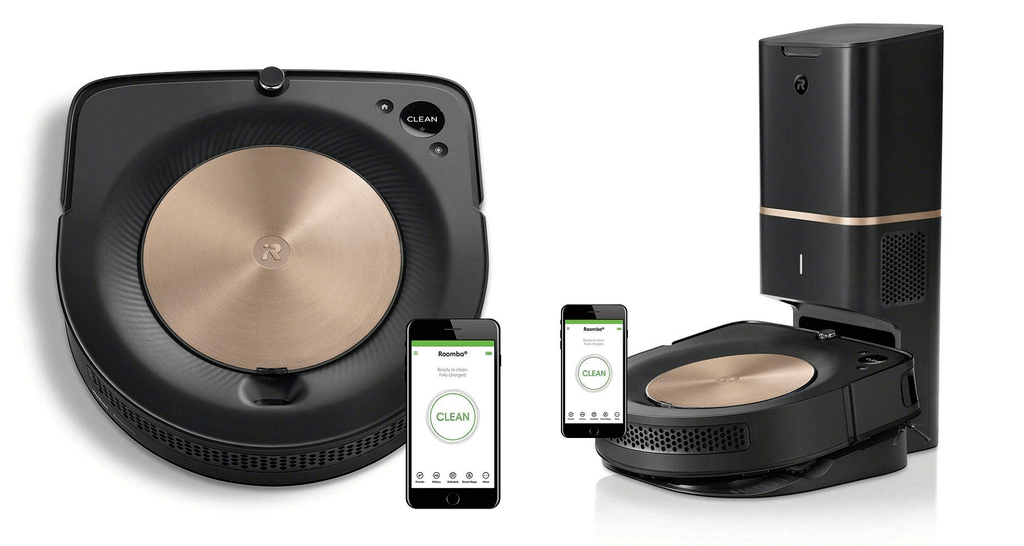
Thank you for showing all the options and also the difference between the s9 and s9+.
Helped me to decide between the two ..thanks